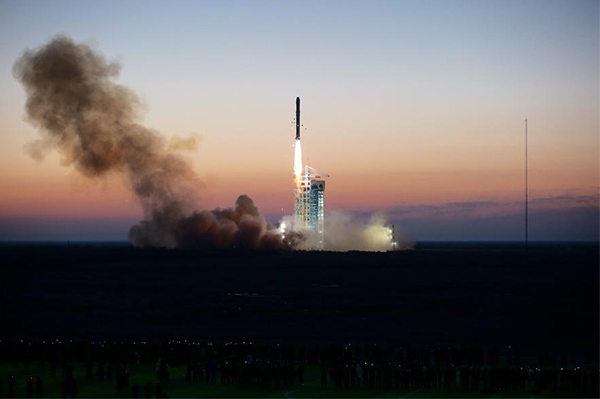China launches first dark matter satellite
 0 Comment(s)
0 Comment(s) Print
Print E-mail Xinhua, December 17, 2015
E-mail Xinhua, December 17, 2015
| Carrier Long March 2-D rocket blasts off at the Jiuquan Satellite Launch Center in Gansu province, Dec 17, 2015, sending into space the country's first Dark Matter Particle Explorer Satellite. [Photo/Xinhua] |
China on Thursday sent into space the country's first space telescope in a fresh search for signals of dark matter, invisible material that scientists say makes up most of the universe's mass.
The Dark Matter Particle Explorer (DAMPE) Satellite, which has been given the moniker "Wukong" after the Monkey King from the Chinese classical fiction "Journey to the West," was launched at 8:12 a.m. Thursday on a Long March 2-D rocket from Jiuquan Satellite Launch Center.
It will enter a sun-synchronous orbit at a height of 500 kilometers to observe the direction, energy and electric charge of high-energy particles in space.
The satellite is designed to undertake a three-year space mission, but scientists hope it could last five.
They also hope the 1.9-tonne desk-sized satellite could help shine more light on the hypothetical mass during that short period.
Dark matter, which does not emit or reflect enough electromagnetic radiation to be observed directly, is one of the huge mysteries of modern science.
Theorized by scientists who could not understand missing mass and strangely bent light in faraway galaxies, dark matter has become widely accepted in the physics community even though its existence has never been concretely proven.
Scientists now believe that only around five percent of the total mass-energy of the known universe is made up of ordinary matter -- protons, neutrons, electrons -- whereas dark matter and dark energy make up the rest.
Exploration of dark matter could, therefore, give us a clearer idea about the past and future of galaxies and the universe, and will be revolutionary for the world of physics and space science, said Chang Jin, chief scientist on the project.
Shedding light on dark matter
Hints of the true nature of dark matter have already emerged from some previous observations, including those conducted by the Alpha Magnetic Spectrometer onboard the International Space Station and by the Large Hadron Collider (LHC) at the CERN physics research center near Geneva, Switzerland.
China also runs an underground dark matter lab in the southwest province of Sichuan, some 2,400 meters under the earth's surface.
So far, scientists have developed three investigative methods -- a particle accelerator that "creates" dark matter particles; special targets underground to see the traces left by colliding dark matter particles; and the calculation of dark matter particles' annihilation or decay that are in space, which help calculate details and space distribution.
DAMPE will support research using the third method, scientists are hoping the findings will help clarify previous observation results and lift the "invisible cloak" of dark matter.
"This is like tracking down the 'son' of dark matter -- if you cannot find the father, you go to the son and you could learn about at least some properties of his father," said Chang.
Wukong will scan space in all directions in the first two years and focus on sections where dark matter is most likely to be observed afterward.
More than 100 scientists will study the data. Initial findings will be published in the second half of 2016.







Go to Forum >>0 Comment(s)